
NGC 3593 is a lenticular galaxy located in the constellation Leo. It has a morphological classification of SA(s)0/a, which indicates it is a lenticular galaxy of the pure spiral type. Despite this, it has a large amount of hydrogen, both in its molecular and atomic (H) form. It is a starburst galaxy, which means it is forming new stars at a high rate. This is occurring in a band of gas surrounding the central nucleus. There is a single arm, which spirals outward from this ring. It is frequently but not consistently identified as a member of the Leo Triplet group.

NGC 3632 and NGC 3626 is an unbarred lenticular galaxy and Caldwell object in the constellation Leo. It was discovered by William Herschel, on 14 March 1784. It shines at magnitude +10.6/+10.9. Its celestial coordinates are RA 11h 20.1m, dec +18° 21′. It is located near the naked-eye-class A4 star Zosma, as well as galaxies NGC 3608, NGC 3607, NGC 3659, NGC 3686, NGC 3684, NGC 3691, NGC 3681, and NGC 3655. Its dimensions are 2′.7 × 1′.9. The galaxy belongs to the NGC 3607 group some 70 million light-years distant, itself one of the many Leo II groups.
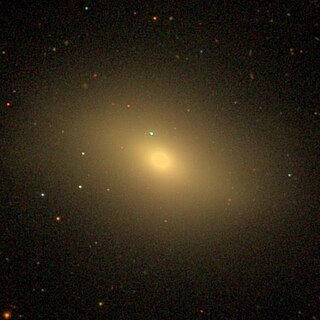
NGC 584 is an elliptical galaxy in the constellation Cetus. The galaxy was discovered on 10 September 1785 by the German-British astronomer William Herschel.

NGC 5775 is a spiral galaxy, a member of the Virgo Cluster, that lies at a distance of about 70 million light-years. Although the spiral is tilted away from us, with only a thin sliver in view, such a perspective can be advantageous for astronomers. For instance, astronomers have previously used the high inclination of this spiral to study the properties of the halo of hot gas that is visible when the galaxy is observed at X-ray wavelengths. It is a member of the NGC 5775 Group of galaxies, itself one of the Virgo III Groups strung out to the east of the Virgo Supercluster of galaxies.

"Legacy Survey Sky Browser". www.legacysurvey.org. Retrieved 2023-05-19.

NGC 3501 is a spiral galaxy 80 million light years away. It is located in the constellation Leo. The galaxy was imaged by the Hubble Space Telescope in 2014, showing an edge-on spiral galaxy; its companion NGC 3507 is not included in the photograph. It is a member of the NGC 3607 Group of galaxies, which is a member of the Leo II Groups, a series of galaxies and galaxy clusters strung out from the right edge of the Virgo Supercluster.

NGC 3718, also called Arp 214, is a galaxy located approximately 52 million light years from Earth in the constellation Ursa Major. It is either a lenticular or spiral galaxy.

NGC 3274 is a relatively faint spiral galaxy discovered by Wilhelm Herschel in 1783, and is located over 20 million light-years away in the constellation of Leo.
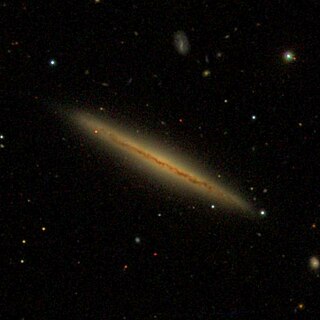
NGC 5470 is an edge-on spiral galaxy located between 43 and 68 million light-years away in the constellation Virgo. It was discovered by astronomer John Herschel in 1830. It is a member of the Virgo III Groups, a series of galaxies and galaxy clusters strung out to the east of the Virgo Supercluster of galaxies.

NGC 3697 is a spiral galaxy in the constellation of Leo. It was discovered on 24 February 1827 by John Herschel. It was described as "extremely faint, very small, extended 90°" by John Louis Emil Dreyer, the compiler of the New General Catalogue. It is a member of HCG 53, a compact group of galaxies.
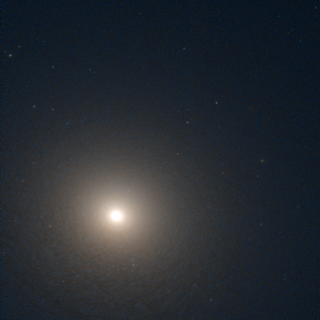
NGC 1400 is an elliptical galaxy in the constellation Eridanus. At a distance of 65 million light-years from Earth, it was discovered by John Herschel in 1786. It is a member of the NGC 1407 group, whose brightest member is NGC 1407. The NGC 1407 group is part of the Eridanus Cluster, a cluster of 200 galaxies.
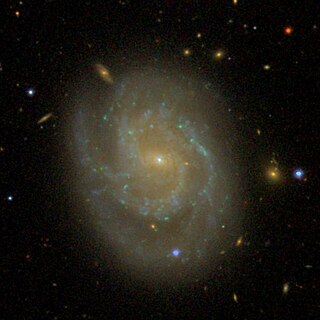
NGC 3686 is a spiral galaxy that forms with three other spiral galaxies, NGCs 3681, 3684, and 3691, a quartet of galaxies in the Leo constellation. It was discovered on 14 March 1784 by William Herschel. It is a member of the NGC 3607 Group of galaxies, which is a member of the Leo II Groups, a series of galaxies and galaxy clusters strung out from the right edge of the Virgo Supercluster.

NGC 531 is a barred spiral galaxy in the constellation Andromeda with a visual magnitude of 10.51. It is a distance of 65.7 Mpc from the Sun. It is a member of the Hickson Compact Group HCG 10, and is interacting with the other members of the group.
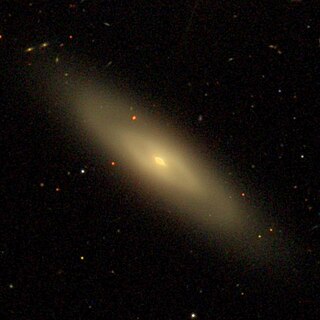
NGC 3301, also known as NGC 3760, is a lenticular galaxy in the constellation Leo. Its apparent magnitude in the V-band is 11.1. It was first observed on March 12, 1784 by the astronomer William Herschel. It is a member of the Leo II Groups, a series of galaxies and galaxy clusters strung out from the right edge of the Virgo Supercluster.

NGC 3902 is an intermediate spiral galaxy in the constellation Leo. It was discovered on April 6, 1785, by William Herschel and observed on February 19, 1827, by John Herschel. It is estimated to be 180 to 185 million light-years away, and its redshift-independent distance estimates to about 185 to 240 million light-years. It is around 75,000 light-years in diameter.
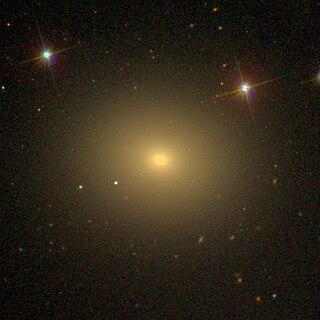
NGC 3608 is an elliptical galaxy located in the constellation Leo. It was discovered by William Herschel on March 14, 1784.

NGC 3414 is a lenticular galaxy in the constellation Leo Minor. It was discovered by William Herschel on April 11, 1785. It is the central galaxy of a rich galaxy group. Two galaxies, NGC 3418 and UGC 5958, have similar redshifts and are within 800,000 light-years of NGC 3414. It is a member of the NGC 3504 Group of galaxies, which is a member of the Leo II Groups, a series of galaxies and galaxy clusters strung out from the right edge of the Virgo Supercluster.

NGC 3254 is a spiral galaxy in the constellation Leo Minor. It was discovered on March 13, 1785 by the astronomer William Herschel. It is a member of the NGC 3254 Group of galaxies, which is a member of the Leo II Groups, a series of galaxies and galaxy clusters strung out from the right edge of the Virgo Supercluster.
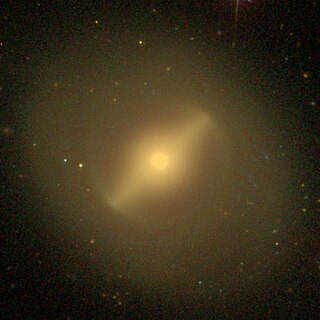
NGC 4643 is a lenticular galaxy located in the constellation Virgo. It is a member of the NGC 4753 Group of galaxies, which is a member of the Virgo II Groups, a series of galaxies and galaxy clusters strung out from the southern edge of the Virgo Supercluster.
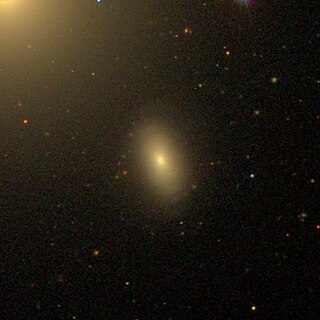
NGC 3605 is an elliptical galaxy located in the constellation Leo. It was discovered on March 14, 1784 by the astronomer William Herschel.




















